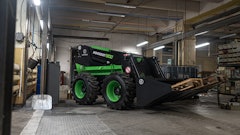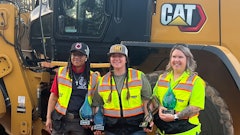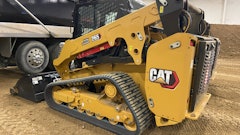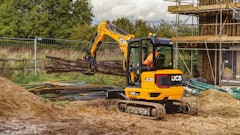
A 2,000-pound wrecking ball crashes into the concrete walls of an aged silo, sending jagged chunks of concrete, dust and debris to the ground. Explosives detonate, reducing once solid structures to rubble. When most people think of demolition, these are the scenes that come to mind. But on one Port of Tampa project, they were exactly what two demolition companies had to avoid.
The Port of Tampa Authority hired Kimmins Contracting to demolish three 150-foot silos and a 180-foot grain elevator that sat just 5 feet away from the nearest of several tanks that store thousands of gallons of highly combustible fuel. Any damage to the nearby tanks could release dangerous fumes or fuel and create serious health and environmental hazards.
Kimmins needed to get the job done cleanly, precisely and safely. To do it, the company turned to True-Line Coring and Cutting and its small yet powerful Brokk machines.
Click here to watch a video about Brokk's introduction of the Brokk 100 demolition machine
No margin for error
The Port of Tampa sits near the west coast of Florida just 25 miles from the open waters of the Gulf of Mexico. The port, which handles a vast array of cargo, is one of the top eight cruise ports in the nation and the largest port in the state. The four structures slated for demolition were located along the east side of the port and had been empty for years. Not only had they become a nuisance, but they also were hindering access to the neighboring fuel tanks. They had to come down.
Kimmins, one of the largest civil engineering and demolition contractors on Florida’s west coast, knew safety was paramount, and meticulous, precise demolition in limited space was the key. Explosives were clearly not an option, and using a wrecking ball could send debris onto the tanks, cause damage and potentially release dangerous fumes. It also could allow fuel to escape and leach into the ocean, which would harm fragile ocean life.
Click here to watch a Brokk 90 climb stairs
Kimmins decided demolishing the buildings with large concrete shears was the safest option. Typically, this process begins by crushing the walls, but this wasn’t a typical job. Demolishing the walls first would cause the concrete above to topple toward the tanks. Instead, the company developed a plan to demolish the ceilings first so debris could be pushed safely inside the structures.
Kimmins knew what needed to be done, but its equipment wasn’t capable of such a precision project; it was an unusual challenge that required an unusual solution. The company called in True-Line out of Tampa.
A top-down strategy
Kimmins hired True-Line specifically because of its capabilities and experience with compact, remote-controlled Brokk machines. “We often work with Kimmins on concrete cutting projects,” said Matt Alexander, president of True-Line’s Tampa office, “but this job was a little different.”
True-Line started by using its saws to cut openings in the sides of the structures. This allowed debris to fall safely inside of each structure as demolition progressed rather than toppling toward the fuel tanks. With parts of the lower walls removed, crews would be able to access the interior and remove debris. The company’s Brokk 180 remote-controlled demolition machine handled the rest of the delicate operation.
“The Brokk was powerful enough to break up the tough concrete, yet light and compact enough to rest on each surface and perform the demolition in tight quarters,” Alexander said. “It was the ideal solution.”
True-Line equipped the Brokk 180 with a breaker and hoisted it to the top of the first silo with a crane. It sat on top of the structure during much of the roof demolition but remained harnessed to the crane. Once the roof began to drop, the crane suspended the Brokk over the building to complete the demolition of the ceilings below.
The Brokk made the job safe by removing all workers from the demolition site, with only one operator needed to control the machine from a safe distance away. Without it, crews with jackhammers would have been hoisted to the roof, where there was significant risk of falling. And, because of Florida’s extreme September temperatures, heat exhaustion or heat stroke were real possibilities.
Once True-Line knocked down the ceilings of all four structures, Kimmins was able to crush what remained of the sides of the structures, again pushing the debris safely into the interior where it could then be removed from the site. The entire project took approximately two months to complete.
True-Line meets Brokk
True-Line Coring and Cutting has been using Brokks on a weekly basis for the past 11 years for a variety of projects, from knocking out warehouse walls to allow for additions to removing interior stairwells to demolishing entire buildings from the inside out. But Alexander was a latecomer.
Ron Dailey, who runs the True-Line Coring and Cutting office in Nashville, was the first within the company to buy a Brokk. “Ron was calling me constantly, telling me about the Brokk machines, saying that I needed to get one,” Alexander said. He was skeptical, but flew from Tampa to Nashville to watch the Brokk in action. He was impressed, but still hesitant. Then an ad headline caught his eye.
“Brokk Does The Work of 20 Men With No Workers’ Comp Claims.”
“What really appealed to me were the capabilities of the machines without the risk of injuries,” Alexander said. He purchased a Brokk 180, and the machine opened avenues of business that True-Line wasn’t able to safely pursue before.
Brokks are ideal for work in confined spaces; they’re small enough to fit into tight spots, and since they’re electric powered there is no potentially harmful exhaust. In addition, operators can run the machines from a distance, away from potentially dangerous situations. Since he made that first purchase, Brokks have boosted jobsite safety and efficiency and diversified the company’s workload. Alexander has since added a Brokk 90 and a second Brokk 180 to his fleet, and he says the company often gets work specifically because of their capabilities.
“We would do some demolition work prior to getting the Brokk machine, but that was all done by handheld tools such as jack hammers,” he said. “It wasn’t efficient, and because it put operators in the line of the work, it left the door open for injuries.”
In the majority of its projects, True-Line uses its Brokks in conjunction with its concrete cutting operations.






























